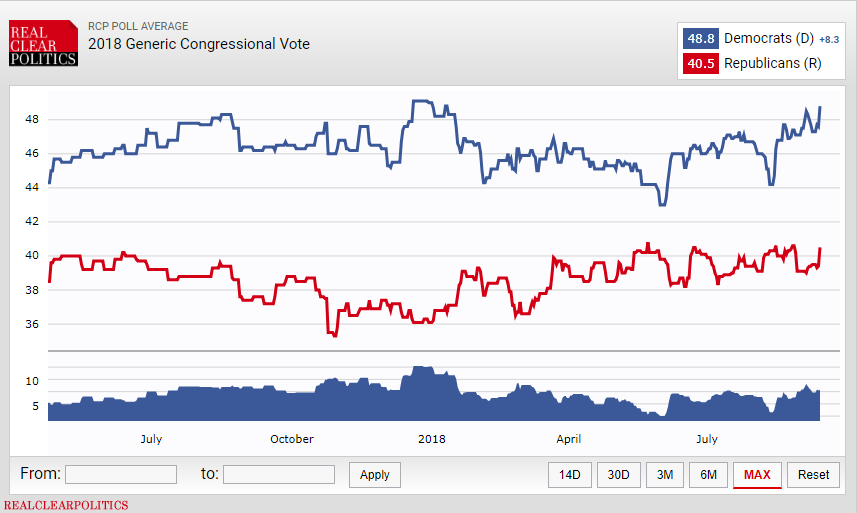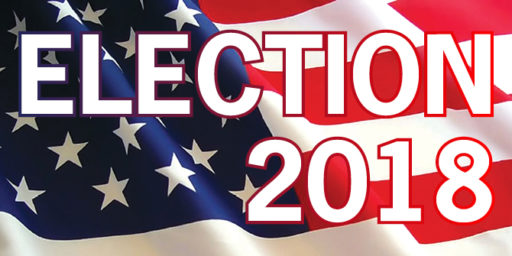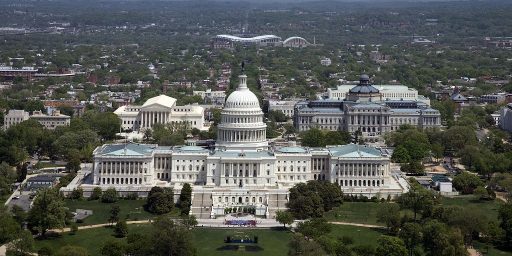Generic Ballot Polling Suggesting The ‘Blue Wave’ Is For Real
A new round of Congressional Ballot polls seems to put Democrats in a strong position for the 'blue wave' they've been hoping for all year.

Just over seven weeks from now, Americans will head to the polls in the first midterm elections of Donald Trump’s tenure as President, and many more will have already voted early or by absentee ballot in states where that is possible, and the pre-election polling continues to look quite favorable for the Democratic Party’s chances of gaining control of at least the House of Representatives for the first time since the 2010 elections.
First up, there’s a new poll from National Public Radio and Marist College that gives Democrats a double-digit lead heading into the midterms:
In a troubling sign for Republicans less than two months before November’s elections, Democrats’ advantage on the question of which party Americans are more likely to vote for in November is ballooning, according to a new NPR/Marist poll.
The gap has widened to 12 percentage points, up from 7 in July — and it is largely because of voters in the Midwest. They have swung 13 points in Democrats’ direction since July. That Midwestern shift is consistent with what Marist has found in statewide polls conducted for NBC in Michigan, Wisconsin and Minnesota that showed President Trump’s support there starting to erode.
“Every way we are looking at the data, the same general pattern is emerging,” said Lee Miringoff, director of the Marist Institute for Public Opinion, which conducted the poll. “The Midwest is an area that is getting restless about what they hoped was going to occur and what they feel is not occurring.”
Trump has waged trade wars with several countries, aiming to renegotiate deals and has instituted tariffs on imports that have been met with retaliatory tariffs on exports. Many of those have taken a toll on Midwestern farmers, for example. And some automakers have come out against Trump’s moves on car imports, hitting Trump with some tough headlines.
And that appears to be sticking to the GOP now.
“Republicans have not only been fairly silent in opposition to the president,” Miringoff said, “but they’ve been driving very hard in the Senate when it comes to his Supreme Court nominee. Congressional Republicans are buying into Trump for November. In terms of brand, they look totally in lockstep with the president — and that has become extremely clear to voters.”
Overall in the poll, half of voters (50 percent) said they are more likely to vote for the Democrat in their congressional district over the Republican (38 percent). In July, the Democratic edge was 47 percent to 40 percent.
These numbers are substantiated by the most recent Quinnipiac Poll:
Democrats hold a 14-point lead over Republicans on the generic House ballot, according to a new poll released by Quinnipiac University on Wednesday.
The survey found that 52 percent of American voters favor a Democratic candidate in the upcoming midterm elections, while 38 percent back a Republican.
The 14-point advantage marks a solid increase for Democrats. In an identical survey in mid-August, the party held a 9-point lead over Republicans.
Democrats have a sizable lead over Republicans when it comes to independent voters. Fifty percent of respondents who identify themselves as an independent say they’d vote for a Democratic candidate. Thirty-five percent intend to vote for a Republican.
A new Politico/Morning Consult poll, meanwhile, gives Democrats a ten-point advantage over Republicans, as does the new CNN/SSRS poll:
Democrats maintain a wide lead over Republicans in the race for control of the House of Representatives, a new CNN Poll conducted by SSRS finds, including a 10-point lead among those most likely to turn out this November.
In a generic ballot test, 52% of likely voters back the Democratic candidate for House of Representatives in their district while 42% back the Republican. Among all registered voters, Democrats hold a 12-point margin over the GOP, suggesting preferences have not shifted much since an August CNN Poll, which did not include an assessment of likely voters.
The new poll marks the first time this election season CNN has looked at preferences among likely voters. Typically, likely voters in midterm elections are a bit more Republican-leaning than the broader pool of registered voters. This year, Democrats are expressing just as much interest in voting as Republicans, and voters who are Democrats or Democratic-leaning independents continue to be more enthusiastic about casting a ballot for Congress than those who tilt toward the GOP (56% are extremely or very enthusiastic vs. 50% of Republican voters).
The results of the poll suggest a midterm environment that is looking a lot like 2006, when Democrats took control of the House amid widespread voter dissatisfaction with Republican president George W. Bush and his handling of the war in Iraq. In 2010, backlash to President Barack Obama and the passage of Obamacare led to the organization of the ideological Tea Party movement, which boosted Republicans back into control of the House. In September of 2006, CNN polling also found Democrats with a 10-point lead over Republicans on the generic ballot.
The President is a negative motivator for a majority of voters, according to the poll, with 54% saying they would be more apt to support a candidate who opposes President Trump. About a third (36%) say they’re partial to supporting a candidate who backs the President. Those figures have shifted against Trump since the question was last asked in May (48% said they’d prefer an anti-Trump candidate in that poll, 43% a pro-Trump one).
Views of the President are closely tied to preferences in the House ballot: Among those likely voters who approve of the way the President is handling his job, 89% plan to back the Republican in their district, while 87% of those who disapprove favor the Democrat.
And more Americans say the country would be better off (40%) than worse off (28%) should Democrats take control of Congress in this November’s elections. That’s a wider margin that felt the nation would be better off should Republicans take control back in 2010. Only about a quarter now (27%) say it doesn’t make a difference, fewer than felt that way in 2014 or 2010, suggesting voters see this year’s contest as more consequential.
The results come as multiple polls show similar shifts in the Democrats’ favor in the dynamics of the midterm race. It is the third poll released in the past two days to show Democrats with a double-digit lead over Republicans on a generic ballot question.
The poll shows Democrats with a huge advantage among women likely voters, 60% say they back the Democrat in their district compared with 36% for the Republican. Among men, Republicans hold a slim 5-point edge. And as in 2016, education is a sharp divider among white voters. Those without college degrees broadly back the Republican (57% for the Republican to 38% for the Democrat) while those who hold four-year degrees favor the Democrat by a similar margin (59% to 37%).
Voters on both sides of the battle for the House say they are largely casting votes to support their candidate rather than to make a stand against their opponent. About 6 in 10 voters who choose the Democrat in their district say they are doing so more to vote for the Democrat than against the Republican. Likewise, 60% of Republican backers say they’re casting a supportive vote for the GOP more than one against the Democrats.
Other polling is somewhat more mixed on where the race stands at this point. The Economist/YouGov poll, for example, gives Democrats (44%) just a three-point lead over Democrats (41%). Additionally, and not surprisingly, the Rasmussen Poll, which has always been something of an outlier on the Generic Ballot question gives Democrats (46%) a four-point lead over Republicans (42%). Finally, the new Reuters/IPSOS poll gives Democrats (49%) an eight-point advantage over Republicans (41%).
What all this means is that there has clearly been a strong and continuing shift in momentum in favor of Democrats that only appears to be getting stronger as we get closer to Election Day.
The RealClearPolitics poll average, for example, puts the Democrats at 48.8% and Republicans at 40.5%, giving Democrats an 8.3 advantage, which is actually down somewhat from where it was two weeks ago. This, however, could be a reflection of the extent to which outlier polls like Rasmussen and YouGov are having on the poll at the moment. The Pollster average for the Generic Ballot, meanwhile, puts Democrats at 45.1% and Republicans at 39.0%, giving Democrats a 6.1 point advantage. This is also a slight dip from where things stood at the start of the month, but not as large a difference as the RealClearPolitics average. FiveThirtyEight’s average, meanwhile, which is somewhat weighted to account for poll reliability, puts Democrats at 49.0% and Democrats at 39.9%, giving Democrats an 9.1 point advantage, also a slight dip from two weeks ago. Finally, the FiveThirtyEight forecast gives Democrats an 82.7% of winning control of the House while Republicans are given a 17.3% chance of retaining control. Notwithstanding the fact that the poll averages have narrowed slightly, as the RealClearPolitics chart shows, the trend clearly seems to be moving in a positive direction for Democrats:

As of right now, Republicans have a 23 seat advantage over Democrats in the House of Representations. This means that Democrats need to pick up a net of at least 24 seats in order to gain control of that body. Based on these Generic Ballot numbers, one would expect that Democrats would pick up as many as 40 seats, which would be more than enough to give them fairly solid control of that body. Additionally, as I’ve stated before, the most recent forecast from the Cook Political Report suggests Democrats could pick up between 25 and 35 seats, and that is is a projection that was made before the Generic Ballot started moving strongly in the Democrat’s direction. If this projection If the Cook Report projection is correct then it means that Democrats would end up with a slim majority in the House. If the polling that has taken place in the wake of that report is accurate, then the Democratic majority would be even more substantial, as would the Republican Party’s headaches in 2019 and 2020 since it would mean that, at the very least, Democrats would use their majority to launch investigations into the Trump Administration not unlike those that Republicans launched during the Obama years. Given these polls, and assuming that the current trend continues, my current projection, which is unchanged from where it was two weeks ago, would be that Democrats would be likely to gain between 35 and 45 seats in the House.
It’s always possible, of course, that this polling could end up being wrong. We saw in 2016 that while the national polls ended up being fairly accurate, the same was not true of many state-level polls, especially those in the upper Midwest where President Trump was able to pull off narrow wins that gave him his narrow Electoral College victory. The same could end up being true of the Generic Ballot poll, which doesn’t necessarily reflect what is happening at the individual district level. Additionally, this poll has historically not been very helpful in predicting how the Senate vote will turn out, and it’s still the case that the Republicans still have a numerical advantage that could permit them to maintain control of that chamber. That, however, is something we won’t know until we get closer to Election Day. Based on the numbers we have, though, it is looking like a very good November for Democrats.





Fake polls.
Who’da thunk, 6 months ago, that Ted Cruz was going to be in a race for his life? And will likely lose? Enthusiasm and momentum is going to drive turnout, but isn’t captured in these polls.
https://www.reddit.com/r/Beto_for_Senate/comments/9gks53/beto_rally_in_plano_tx_this_weekend_absolutely/
Big grain of salt wrt polling. I’d hate to be the guy in charge of turnout models at any of the polling companies. Dems are fired up. But are the kids going to finally go to the polls? I have no idea how motivated the R base is. I forget who in these threads has pointed out that TX has a ballot that makes it a pain to not vote straight ticket.
A big enough wave could even turn control of the Senate.
The bad news is the Senate map is so unfavorable for the Democrats, they may not win control even if the blue wave breaks all records.
As usual, hope for the best and prepare for the worst.
For those of you wondering why Dianne Feinstein waited until the last second to bring up Kavanaugh’s problem, the above is why.
@Kathy:
I believe it’s interconnected, though. If Dems pick up, say, around 25-30 seats in the House, enough to acquire a narrow majority in that chamber, they probably wouldn’t win control of the Senate and they may well end up with fewer Senate seats than before. That’s perfectly plausible given the current map. However, if they win upwards of 45+ House seats, I believe they will also capture the Senate, quite possibly with more than 51 seats. As I pointed out yesterday, 538 currently gives them a better-than-even chance in each of the individual Senate races that would collectively hand them a majority. A big enough blue wave would likely pull Democrats across the line in all those races, especially given that they have nominated excellent candidates. I simply don’t believe the national trend is that separable from what’s happening at the state level, despite the challenging map.
A great deal will depend on turnout. Democrats are generally a bit lax when it comes to voting in off-year elections, but they appear to be motivated this year. Anecdotes are not data, but in my little NH town–which went for Trump in 2016–there were contested congressional primaries on both the R and D sides (incumbent is retiring/not running, so open seat). For last week’s primary election, more Democratic ballots were cast than Republican ones…again, in a town that voted for Trump.
There is a delicious irony at play, which I don’t know how many have noticed….
Trump is telling his base that there will be a “Red Wave” and that all news about a “Blue Wave” is “Fake News!”…. BUT…. this has led several pollsters to note that Trump’s rhetoric is creating a very complacent GOP Base, that isn’t likely to turn out due to their real belief that Trump is on top of all things “Fake News.”.
It could well be that Trump’s own words depress the GOP turnout.
That would be delicious, if it’s proven to be the case.